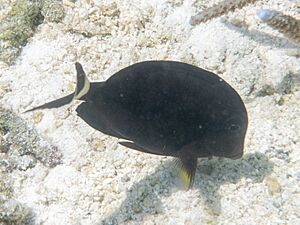Orange-socket surgeonfish facts for kids
Quick facts for kids Orange-socket surgeonfish |
|
|---|---|
 |
|
| Conservation status | |
| Scientific classification |
The Acanthurus auranticavus, also known as the orange-socket surgeonfish or ringtail surgeonfish, is a type of ray-finned fish that lives in the ocean. It belongs to a group of fish called Acanthuridae, which includes surgeonfishes, unicornfishes, and tangs. You can find this fish in the Indo-West Pacific region of the world.
About This Fish
This fish was first officially described in 1956 by an American scientist named John Ernest Randall. He studied fish, and he found this one near Ataluyan Island in the Lagonoy Gulf in the Philippines. The name auranticavus comes from two Latin words: aurantia, meaning "orange", and cavus, meaning "cavity" or "socket". This name refers to the bright orange spot where the fish's sharp tail spine is located.
What It Looks Like
The orange-socket surgeonfish has a dark brown body. It has a special sharp spine on its tail, which is about a quarter to half the length of its head. This spine sits in a bright orange socket, which is how it got its name! You might also see some orange-brown areas under its pectoral fin (the fins on its sides).
Its eyes have orange spots in front and behind the pupil. A cool feature is a white band around the base of its caudal fin (tail fin). This fish can grow up to about 45 centimeters (about 18 inches) long.
Where It Lives and What It Does
You can find the orange-socket surgeonfish in the Indian Ocean and the western Pacific Ocean. In the Indian Ocean, it has been seen near the Maldives, the Seychelles, and Christmas Island. In the Western Pacific, it's more common in places like the Philippines, Indonesia, Malaysia, Samoa, the Solomon Islands, and Papua New Guinea.
In Australia, these fish live on the northern Great Barrier Reef and other reefs in the Coral Sea. They might even be found as far south as Lady Elliot Island in Queensland. They have also been spotted at Ashmore Reef, Scott Reef, and Rowley Shoals in the Timor Sea.
Adult orange-socket surgeonfish like to hang out near shallow water reefs. They can be found both inside the calm lagoon areas and on the outer parts of the reef. They often swim together in large groups, sometimes even with other types of fish. Younger fish, called juveniles, prefer very shallow water, usually less than 2 meters (about 6.5 feet) deep, where they hide among soft corals.
See also
 In Spanish: Acanthurus auranticavus para niños
In Spanish: Acanthurus auranticavus para niños


